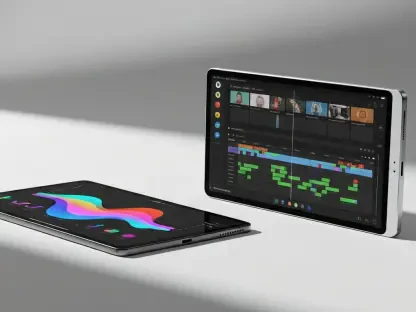In a pioneering move that promises to reshape the digital landscape, Google announced plans to merge its two major operating systems, ChromeOS and Android, into a unified platform. This initiative, shared through insights by Sameer Samat, President of the Android ecosystem at Google, heralds a strategic evolution that has long been the subject of speculation within the tech industry. The integration aims to streamline app ecosystems, enhance functionality, and ensure seamless user experiences across Google devices. Such an announcement is monumental, affirming years of anticipation about the convergence of these two powerful systems.
Current State and Challenges of ChromeOS and Android
The Complexity of Dual Platforms
Since 2019, Chromebooks have had the capability to run Android apps alongside those from the Chrome Web Store. This dual-platform approach often leads to user confusion, as individuals struggle to determine which store to access for their desired apps. For users, this can be frustrating when navigating between Google Play Store and Chrome Web Store, compounded by the irregular performance of certain Android apps on ChromeOS. Specifically, some applications, like Discord, do not adapt well to Chromebook screens, prompting display issues and functionality limitations.
These challenges underscore the need for a more cohesive system, and Google’s announcement marks a significant step towards addressing them. By unifying ChromeOS and Android, the company seeks to create a more intuitive user experience where applications perform seamlessly across devices. Such integration is particularly pertinent given the diverse range of devices, from phones to laptops, that users operate in their daily lives. This is not only a technical endeavor but an effort in elevating user satisfaction and accessibility.
Industry Speculation and Strategic Intent
Industry analysts have speculated on the potential merger of ChromeOS and Android for years, seeing it as a natural progression given the growing overlap between the two ecosystems. Now confirmed, the strategic intent is clear: to simplify technology interactions by eliminating the fragmented experience users currently face. Google’s vision aligns with broader trends toward consolidation in the tech world, wherein companies aim to provide more unified, flexible platforms that cater to varied user needs across different hardware environments.
The anticipated fusion of these systems signals a dedication to enhancing performance, reducing redundancy, and delivering a more cohesive suite of applications. This approach not only assists users in accessing a broader range of applications but also optimizes developer resources, enabling greater innovation within a unified system. Such strategic alignment could potentially redefine the operational capabilities of both ChromeOS and Android, setting a precedent for further technological advancements within the industry.
Future Integration and Technical Advancements
Vision for Seamless Experience
According to Sameer Samat, Google’s plan to merge ChromeOS and Android is poised to create a singular ecosystem that resolves current app store confusion and boosts overall app functionality. This integration is vital in light of Android’s advancements to support larger screens, suggesting a readiness for desktop operating system features. The future iteration of Android and ChromeOS promises smoother app deployment across diverse screen sizes, enhancing user interaction regardless of the device type.
By fortifying the intersection between ChromeOS and Android, Google is responding to an evolving digital landscape where users demand fast, efficient, and seamless transitions between various platforms. This ambition reflects a broader industry move toward multi-platform adaptability, wherein applications can dynamically adjust to different devices without compromising user experience or operational efficiency. Google’s integration strategy will likely elevate the usability and coherence of its service offerings, aligning with similar cross-platform endeavors seen across competing technology giants.
Enhancing Device Compatibility
ChromeOS has gradually de-emphasized web apps over recent years, igniting the shift toward Android apps as a more central component of its service offering. Initially, the Chrome Web Store aimed to provide broader compatibility across multiple operating systems. However, as technology trends favor mobile-first solutions, Android has emerged as a primary focus, redefining the version of ChromeOS into an Android-centric model. This pivot is exemplified by Android’s ability to accommodate larger screens, suggesting a shift towards functionalities commonly associated with desktop environments.
By bridging the gap between mobile and desktop interactions, Google’s integration strategy is set to redefine how applications operate across diverse devices. The convergence strategy is indicative of a commitment to performance enhancement and optimization for future technological challenges, potentially broadening device compatibility and user engagement. Moreover, by focusing on Android’s development to support broader screen adaptation, Google establishes a roadmap for sustained innovation that could lead to substantial efficiency gains and user satisfaction improvements.
Impact on Users and Sectors
Education Sector Influence
Chromebooks have become integral within the education sector, where ChromeOS serves as the primary interface for numerous schools and educational organizations. The Chrome Web Store extensions remain essential for educators and students, facilitating educational tools and resources. Google’s merger strategy does not imply the removal of ChromeOS features but aims to enrich user experiences through advanced integration that offers more seamless access to applications and extensions.
This enhanced access can significantly impact the educational environment, allowing teachers and students to utilize applications effectively without being hindered by technology constraints. The transition towards a unified platform heralds opportunities for enriched educational experiences and resources that adapt dynamically to evolving academic requirements. By ensuring continuity in support for ChromeOS features within education, Google reaffirms its commitment to serving specialized sectors while pursuing groundbreaking technological integration.
User Experience and Interaction
For everyday users, a unified ecosystem promises to revolutionize how they engage and interact with their devices. The merger is expected to amend existing limitations by seamlessly incorporating Android applications into Chromebooks’ operational capabilities. Historical setbacks, such as constrained application windows, will be addressed through Google’s commitment to improving adaptability across various file formats and screen sizes.
Google’s new approach focuses on optimizing user experience so individuals can navigate applications without compromising functionality or performance. This could translate to quicker access to apps, improved interface design, and a more personalized journey when interacting with technology. As application adaptability advances, users gain greater access to diverse content platforms, contributing to a broader digital engagement reflective of contemporary technological expectations.
Development and Implementation Prospects
Project Strategy and Execution
Google’s Android 16 introduction brings several core features designed to enhance app compatibility across larger screens, a pivotal step as one anticipates future integrations. Google’s meticulous approach to this evolution involves synchronizing development efforts with desktop-centric capabilities that employ Android’s adaptability potential. This strategy strongly indicates predictive moves towards minimizing ChromeOS’s independent functionalities for enriched multi-platform synergy.
The announcement reflects a larger effort to consolidate Google’s operating systems, thereby facilitating more focused resource allocation and technological innovation. The planned merger marks a watershed in software synthesis, wherein a single unified entity prospectively supports broader user needs. Such directed strategy is pivotal for digital organizations, enhancing performance predictably amidst rapid advancements in OS technology domains.
Anticipated System Synergy
Integration expectations posit a dynamic convergence mirroring iOS and iPadOS’s intertwined relationship, demonstrating Google’s dedication to maintaining distinct system attributes for device-specific utilization. Simultaneously, this juxtaposition promises shared foundational experiences, allowing users to leverage consistent across-platform interactions. Through cohesive system synergy, Google’s transposition aligns tightly with trending cross-platform seamlessness witnessed among leading industry players, enhancing user accessibility.
This interconnected synergy potentially revolutionizes how Google services operate across varying technologies, fostering enhanced collaboration between hardware and software components. The convergence aligns with broader trends favoring streamlined experiences, where technology continually adapts to user demands. Such cross-platform strategy promises to redefine Google’s technological identity, facilitating more holistic digital interactions and fostering foundational shifts towards universalized performance coherence in application deployments.
Insights and Conclusions
Industrial Trends and Perspectives
The industry consensus surrounding Google’s merger strategy is robust, reflecting excitement over unified app ecosystems within Chromebooks. By mirroring successful integration strategies seen within Apple, Google’s initiative emphasizes streamlined usability and cross-device functionality, redefining user interactions within its operational scope. Analysts highlight anticipated benefits such as resource optimization for developers, facilitating focused innovation and product enhancement within unified system frameworks.
While strategic anticipation is evident, the absence of definitive timelines triggers debates about the transition’s actuality. Some suggest the merger might span up to five years, though ongoing technological advancements could usher in significant progress sooner. Such uncertainties offer projections grounded in existing developments rather than speculative forecasts, indicating restrained optimism without the dissolution of expectations.
Summary of Major Takeaways
In an innovative move set to transform the digital world, Google has announced its intention to merge its two leading operating systems, ChromeOS and Android, into a singular platform. This ambitious plan was revealed through insights shared by Sameer Samat, the President of Google’s Android ecosystem. This development marks a significant strategic shift that has been speculated about in the tech industry for quite some time.
The unified platform aims to simplify and improve app ecosystems, elevate functionality, and provide a seamless user experience across all Google devices. The integration is expected to create a more cohesive environment for developers and users, offering the best features of both operating systems while eliminating inconsistencies. Users will likely benefit from synchronized updates and a more unified interface that leverages the strengths of both Android and ChromeOS.
This announcement is not just a technological advancement but a confirmation of expectations that have been brewing for years about the potential convergence of these two formidable systems. This merging reflects Google’s strategic vision of harnessing the power of its technologies to deliver superior value and performance, positioning the company at the forefront of innovation. The implications of this integration could redefine how we interact with technology, providing a more interconnected and versatile ecosystem.









